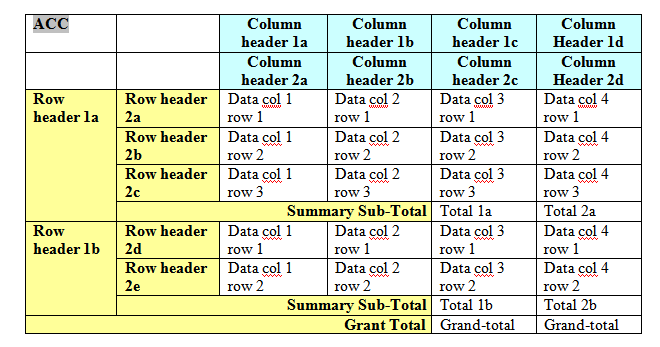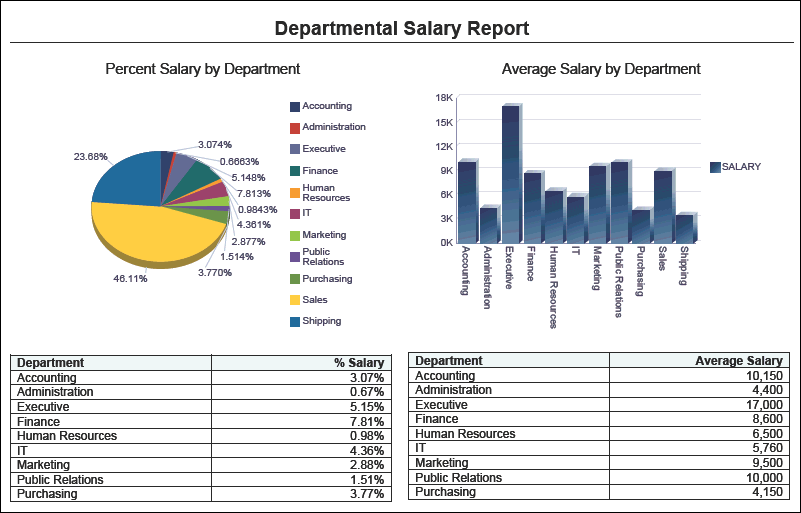Designing Accessible Reports Using RTF Templates
This section describes the following techniques for designing reports using RTF templates. Accessibility support is for HTML output only.
Avoiding Nested Tables or Separated Tables
Avoid using nested tables in a report. For a complex report, try breaking down complex tables into several simple, straightforward tables.
The following figure shows a simple table.
The following figure shows an example of a nested table: A table is inserted inside a table-cell.
Examples
These are examples of table structures that BI Publisher does and does not support for accessibility.
Table Headers Must Not Be Separated from the Table Body
To ensure accessibility, table headers must be part of the table they belong to.
The example shown in the following illustration is not supported because the header, table body and accessibility fields exist in three different tables.
These three tables should be joined into one to support accessibility, as shown in the following illustration.
Defining a Document Title
You can define a document title. The procedure differs slightly depending on the version of Microsoft Word.
To define or change a document title in Microsoft Word 2007:
-
Click the Office button, click Prepare, and then click Properties.
To define or change a document title in previous versions of Word:
- On the File menu, click Properties, then click the Summary tab.
Defining Alternative Text for an Image
To define alternative text for an image in the template:
Note:
In versions of Word prior to 2007, enter the alt:text syntax on the Web tab.
Defining a Table Summary
Add a table summary to a table by inserting this command.
<?table-summary: 'My Table Test '?>
in the first column and first row position of the table.
Defining a Table Column Header
You can define a table column header. The procedure differs slightly depending on the version of Microsoft Word.
To define a table column header in Word 2007:
-
Select the heading row or rows. The selection must include the first row of the table.
-
On the Design tab, in the Table Style Options group, select Header Row.
-
Right-click the table and select Table Properties.
-
In the Table Properties dialog, click the Row tab and then select Repeat as Header row at the top of each page.
To define a table column header in previous versions of Word:
- Select the heading row or rows. The selection must include the first row of the table.
- On the Table menu, click Heading Rows Repeat.
Defining a Table Row Header
To define multiple row headers, use the BI Publisher command.
<?acc-row-header:col_index?>
Example Usage:
<?acc-row-header:'1,2,4'?> ==> column 1, 2 and 4 will be row-headers.
<?acc-row-header:'1,4'?> ==> column 1 and 4 will be row-headers.
In the following figure, the code behind the ACC field is:
ACC Field=<?table-summary:'My Table Test '?><?acc-row-header:'1,2'?>
which defines the first two columns as row headers.
Sample Supported Tables
The following illustrations display sample tables for which accessibility is supported.
Converting Charts to Tables
Charts and gauges are not readable by the visually impaired. In order to make report output accessible for visually impaired users, create a table or cross tab that summarizes the data in the table.
The following figure shows the summarized data in the table. Ideally, the data is summarized at the same level as it is in the chart. Avoid providing a large table of detail data that is not summarized appropriately.











